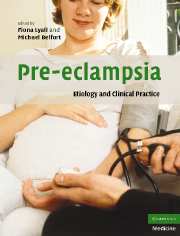Book contents
- Frontmatter
- Contents
- List of contributors
- Preface
- Part I Basic science
- 1 Trophoblast invasion in pre-eclampsia and other pregnancy disorders
- 2 Development of the utero-placental circulation: purported mechanisms for cytotrophoblast invasion in normal pregnancy and pre-eclampsia
- 3 In vitro models for studying pre-eclampsia
- 4 Endothelial factors
- 5 The renin–angiotensin system in pre-eclampsia
- 6 Immunological factors and placentation: implications for pre-eclampsia
- 7 Immunological factors and placentation: implications for pre-eclampsia
- 8 The role of oxidative stress in pre-eclampsia
- 9 Placental hypoxia, hyperoxia and ischemia–reperfusion injury in pre-eclampsia
- 10 Tenney–Parker changes and apoptotic versus necrotic shedding of trophoblast in normal pregnancy and pre-eclampsia
- 11 Dyslipidemia and pre-eclampsia
- 12 Pre-eclampsia a two-stage disorder: what is the linkage? Are there directed fetal/placental signals?
- 13 High altitude and pre-eclampsia
- 14 The use of mouse models to explore fetal–maternal interactions underlying pre-eclampsia
- 15 Prediction of pre-eclampsia
- 16 Long-term implications of pre-eclampsia for maternal health
- Part II Clinical Practice
- Subject index
- References
4 - Endothelial factors
from Part I - Basic science
Published online by Cambridge University Press: 03 September 2009
- Frontmatter
- Contents
- List of contributors
- Preface
- Part I Basic science
- 1 Trophoblast invasion in pre-eclampsia and other pregnancy disorders
- 2 Development of the utero-placental circulation: purported mechanisms for cytotrophoblast invasion in normal pregnancy and pre-eclampsia
- 3 In vitro models for studying pre-eclampsia
- 4 Endothelial factors
- 5 The renin–angiotensin system in pre-eclampsia
- 6 Immunological factors and placentation: implications for pre-eclampsia
- 7 Immunological factors and placentation: implications for pre-eclampsia
- 8 The role of oxidative stress in pre-eclampsia
- 9 Placental hypoxia, hyperoxia and ischemia–reperfusion injury in pre-eclampsia
- 10 Tenney–Parker changes and apoptotic versus necrotic shedding of trophoblast in normal pregnancy and pre-eclampsia
- 11 Dyslipidemia and pre-eclampsia
- 12 Pre-eclampsia a two-stage disorder: what is the linkage? Are there directed fetal/placental signals?
- 13 High altitude and pre-eclampsia
- 14 The use of mouse models to explore fetal–maternal interactions underlying pre-eclampsia
- 15 Prediction of pre-eclampsia
- 16 Long-term implications of pre-eclampsia for maternal health
- Part II Clinical Practice
- Subject index
- References
Summary
Introduction
Vascular tone is influenced by the autonomic nervous system, intrinsic vascular smooth muscle reflexes and the endothelium (Figure 4.1). The endothelium is the cell layer lining the internal surface of blood vessels and in a person weighing 70 kg, covers an area of approximately 700 m2 and weighs between 1 and 1.5 kg (Luscher and Barton, 1997). The endothelium is responsible for an extensive array of highly specialized, homeostatic functions. It plays an important role in the control of blood pressure, blood flow, angiogenesis, coagulation, fibrinolysis, vessel patency, and local inflammatory responses. These functions are achieved through the release of endothelium-derived relaxing and contracting factors, thromboregulatory molecules, growth factors, and neutrophil adhesion molecules (Petty and Pearson, 1989) (Table 4.1). Impaired endothelial function contributes substantially to cardiovascular disorders such as hypertension, atherosclerosis and pre-eclampsia.
Stimulation of endothelial receptors activates pathways within the endothelium that mediate either relaxation or constriction of the underlying vascular smooth muscle. Endothelial responses are triggered by acetylcholine (ACh), serotonin (5-HT), angiotensin II (AngII), vasopressin (AVP), histamine, bradykinin and several other vasoactive hormones (Hill et al., 2001; Lincoln and Burnstock, 1990; Vanhoutte and Rimele, 1983). Endothelial-derived vasoactive factors influence vascular smooth muscle tone through prostaglandins, which are both vasodilatory (prostacyclin) and vasoconstrictor (thromboxane) (Moncada et al., 1976; Mombouli and Vanhoutte, 1999), endothelins, which are predominantly vasoconstrictor (Bagnall and Webb, 2000), endothelial-derived hyperpolarizing factor (EDHF), which is predominantly vasodilator (Chen et al., 1988; Garland et al. 1995), but still not fully characterized, and nitric oxide, which is a vasodilator (Palmer et al., 1987; Vallance et al., 1989).
- Type
- Chapter
- Information
- Pre-eclampsiaEtiology and Clinical Practice, pp. 50 - 77Publisher: Cambridge University PressPrint publication year: 2007



